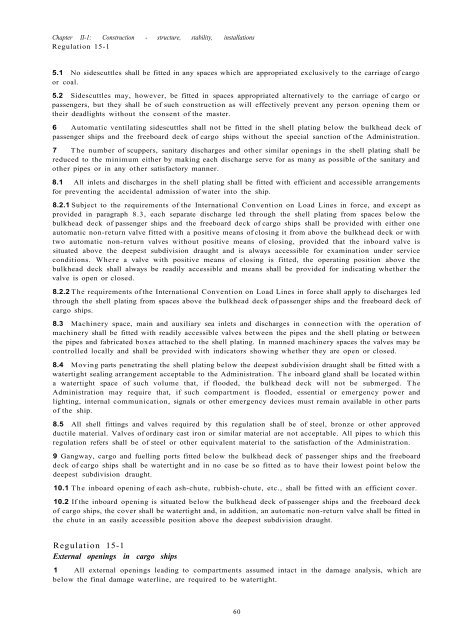Solas Consolidated Edition 2009.pdf
Solas Consolidated Edition 2009 for maritime
Solas Consolidated Edition 2009 for maritime
You also want an ePaper? Increase the reach of your titles
YUMPU automatically turns print PDFs into web optimized ePapers that Google loves.
Chapter II-1: Construction - structure, stability, installations<br />
Regulation 15-1<br />
5.1 No sidescuttles shall be fitted in any spaces which are appropriated exclusively to the carriage of cargo<br />
or coal.<br />
5.2 Sidescuttles may, however, be fitted in spaces appropriated alternatively to the carriage of cargo or<br />
passengers, but they shall be of such construction as will effectively prevent any person opening them or<br />
their deadlights without the consent of the master.<br />
6 Automatic ventilating sidescuttles shall not be fitted in the shell plating below the bulkhead deck of<br />
passenger ships and the freeboard deck of cargo ships without the special sanction of the Administration.<br />
7 The number of scuppers, sanitary discharges and other similar openings in the shell plating shall be<br />
reduced to the minimum either by making each discharge serve for as many as possible of the sanitary and<br />
other pipes or in any other satisfactory manner.<br />
8.1 All inlets and discharges in the shell plating shall be fitted with efficient and accessible arrangements<br />
for preventing the accidental admission of water into the ship.<br />
8.2.1 Subject to the requirements of the International Convention on Load Lines in force, and except as<br />
provided in paragraph 8.3, each separate discharge led through the shell plating from spaces below the<br />
bulkhead deck of passenger ships and the freeboard deck of cargo ships shall be provided with either one<br />
automatic non-return valve fitted with a positive means of closing it from above the bulkhead deck or with<br />
two automatic non-return valves without positive means of closing, provided that the inboard valve is<br />
situated above the deepest subdivision draught and is always accessible for examination under service<br />
conditions. Where a valve with positive means of closing is fitted, the operating position above the<br />
bulkhead deck shall always be readily accessible and means shall be provided for indicating whether the<br />
valve is open or closed.<br />
8.2.2 The requirements of the International Convention on Load Lines in force shall apply to discharges led<br />
through the shell plating from spaces above the bulkhead deck of passenger ships and the freeboard deck of<br />
cargo ships.<br />
8.3 Machinery space, main and auxiliary sea inlets and discharges in connection with the operation of<br />
machinery shall be fitted with readily accessible valves between the pipes and the shell plating or between<br />
the pipes and fabricated boxes attached to the shell plating. In manned machinery spaces the valves may be<br />
controlled locally and shall be provided with indicators showing whether they are open or closed.<br />
8.4 Moving parts penetrating the shell plating below the deepest subdivision draught shall be fitted with a<br />
watertight sealing arrangement acceptable to the Administration. The inboard gland shall be located within<br />
a watertight space of such volume that, if flooded, the bulkhead deck will not be submerged. The<br />
Administration may require that, if such compartment is flooded, essential or emergency power and<br />
lighting, internal communication, signals or other emergency devices must remain available in other parts<br />
of the ship.<br />
8.5 All shell fittings and valves required by this regulation shall be of steel, bronze or other approved<br />
ductile material. Valves of ordinary cast iron or similar material are not acceptable. All pipes to which this<br />
regulation refers shall be of steel or other equivalent material to the satisfaction of the Administration.<br />
9 Gangway, cargo and fuelling ports fitted below the bulkhead deck of passenger ships and the freeboard<br />
deck of cargo ships shall be watertight and in no case be so fitted as to have their lowest point below the<br />
deepest subdivision draught.<br />
10.1 The inboard opening of each ash-chute, rubbish-chute, etc., shall be fitted with an efficient cover.<br />
10.2 If the inboard opening is situated below the bulkhead deck of passenger ships and the freeboard deck<br />
of cargo ships, the cover shall be watertight and, in addition, an automatic non-return valve shall be fitted in<br />
the chute in an easily accessible position above the deepest subdivision draught.<br />
Regulation 15-1<br />
External openings in cargo ships<br />
1 All external openings leading to compartments assumed intact in the damage analysis, which are<br />
below the final damage waterline, are required to be watertight.<br />
60


